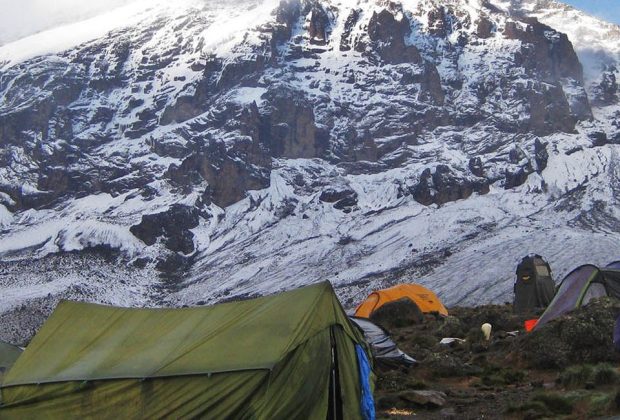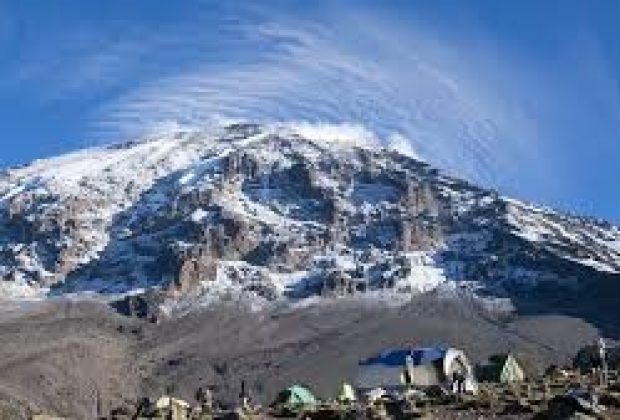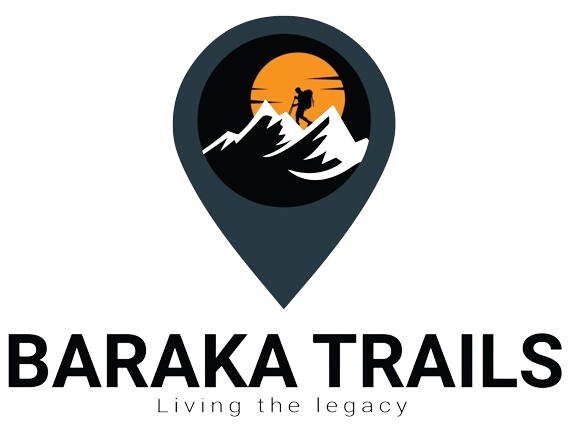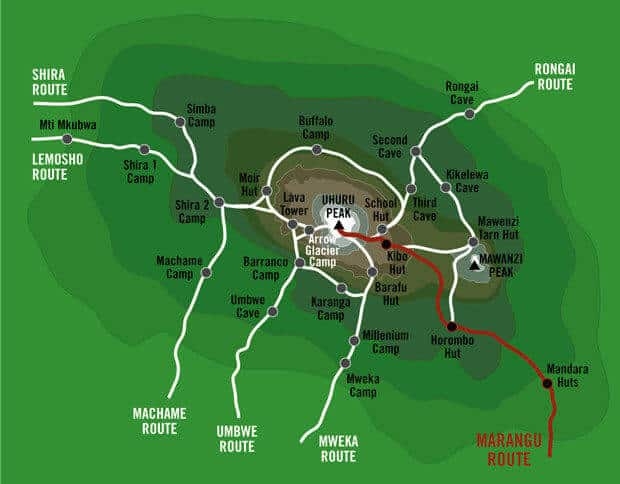8 Days Lemosho Route



The 7-day Lemosho Route on Mount Kilimanjaro is a great choice for climbers looking for a good balance between acclimatization and time spent on the mountain. It offers stunning scenery and a higher success rate compared to shorter routes due to its gradual ascent profile.
DAY 1 Londorossi gate (2,250 m) – Big Tree Camp (2,780 m)
After breakfast you will be picked up at the lodge and drive to the Londorossi Gate at the height of 2,250 m to start your 7 Days Lemosho Route Climbs. After the necessary registration has been completed, a bumpy drive will take you into the dense rainforest, from where your adventure commences. The moderately steep track makes its way through an unspoilt natural forest to the Big Tree Camp (2,780 m). You will be accompanied by an armed ranger for the first 2 days of your trek as wild game can be found in the area. You will spend the night in tents at Big Tree Camp.
7,742 ft to 9,498 ft, 4 miles, approx. 3-4 hours
DAY 2 Big Tree Camp (2,780 m) – Shira Camp 2 (3,900 m)
You have a long trek ahead today on a small trail, passing through the rainforest. As you ascend, the forest gradually thins out and the landscape becomes more dry and bare. On the moorland you will find lobelia and ericas dotting the landscape. You will pass Shira ridge before reaching Shira Camp 1 after 4 to 5 hours. Here you will have your lunch break and rest your limbs, enjoying the views of Mt Meru and the Rift Valley in the distance. You will trek for about another 3 hours, ascending 250 m. Walking on solidified lava, you will pass giant senecios, almost 9 meters in height, before finally reaching your destination of the day, the Shira Camp 2. You will enjoy an evening meal and with a little bit of luck you will be able to see the summit basking in the orange glow of the sunset.
9,498 ft to 11,500 ft, 5 miles, approx. 5-6 hours
DAY 3 Shira Camp 2 (3,900 m) – Lava Tower (4,640 m) – Barranco Camp (3,960 m)
Today’s stretch will allow your body to acclimatise to the ever increasing altitude. Your destination for the day is the Barranco Camp, only slightly higher than the previous night’s stay, but it will be reached through a detour to Lava Tower at 4,640 m in height. The ascent begins with a long trek above the Shira Plateau in the direction of the Lava Tower. The landscape slowly changes to alpine desert and the vegetation becomes less and less. Passing through the lobelia and senecio filled Barranco Valley, you will reach your camp after 6 – 7 hours of walking. Your camp for the evening is the Barranco Camp, said to be one of the most beautiful camps on the mountain.
13,800 ft to 15,223 ft (Lava Tower), down to 13,044 ft, 7km, 4-6 hours
DAY 4 Barranco Camp (3,960 m) – Karanga Camp (4,035 m)
Many ascents and descents are on the agenda for today. You will start the journey tackling the steepest part of the entire route – the Barranco Wall. As you climb you might need to use your hands, but your guides will always be close by to offer assistance. At the top of the Barranco wall you will walk along the mountain ridge, which offers spectacular views of the southern glacier of Kibo as well as the summit itself. Around lunch time you will arrive at Karanga Camp, where a well-deserved rest is the order of the day.
13,044 ft to 13,123 ft, 3 miles, 4-5 hours
DAY 5 Karanga Camp (4,035 m) – Barafu Camp (4,640 m)
After breakfast you will continue through the alpine desert until you have reached the Barafu Camp, situated at an altitude of 4,640 m. The journey takes about 3 to 4 hours giving you enough time to relax and prepare for the summit night ahead. An early dinner will be followed by an early bedtime, before being awoken at around midnight.
15,288 ft to 19,341 ft to 12,467 ft, 3 miles ascent, 7 miles descent, 7-8 hours ascent, 4-6 hours descent
DAY 6 Barafu Camp (4,640 m) – Uhuru Peak (5,895 m) – Mweka Camp (3,080 m)
After a light snack and some hot tea, you will be ready to start the dark ascent to Uhuru Peak at around midnight. You will walk on frozen lava ash, using your headlamp to light the way. After 5 to 7 hours you will arrive at the crater rim of Mt Kilimanjaro, Stella Point. You will continue along the crater ridge which will lead you to the “Roof of Africa”, the summit of Uhuru Peak (5,895 m). The landscape shimmers and shines in the light of the rising sun before you. After all the necessary photos have been taken, you will return to a smiling crew at Barafu Camp. After a hot lunch and well-deserved break, you will make your way to Mweka Camp, where you will camp for the night.
12,467 ft to 5,380 ft, 6 miles, 3-4 hours
DAY 7 Mweka Camp (3,080 m) – Mweka Gate (1,630 m) – Moshi
Your amazing adventure comes to an end with a traditional farewell ceremony by your mountain crew before a gentle descent through the rainforest to Mweka Gate. Your driver will be waiting for you and he will take you back to the Hotel, where you can enjoy a shower and celebrate your wonderful achievement.
Hours descending: 4-7
Key Points
- Acclimatization: The 8-day itinerary provides good acclimatization opportunities with gradual elevation gains and time to adjust to the altitude.
- Scenery: The route traverses diverse ecosystems, offering stunning views and varied landscapes, from lush rainforests to alpine deserts and arctic conditions at the summit.
- Difficulty: Moderate to high; the trek requires good physical fitness and stamina.
Preparation Tips
- Physical Fitness: Prepare with cardio exercises, strength training, and hiking to build endurance.
- Gear: Pack for a range of weather conditions, including warm clothing for high altitudes and rain gear for the rainforest sections.
- Health: Stay hydrated, eat well, and listen to your body to manage altitude sickness. Consider taking medication like Diamox for acclimatization, after consulting with your doctor.
This 7-day Lemosho Route itinerary offers a balance of challenge and enjoyment, making it one of the most recommended routes for those aiming to reach the Roof of Africa
- Price Include:
* All transfers* Accommodation
* all trekking fees,
* All meals while on the Mountain
* Guides, Porters, cook salaries and park fees
* Quality Mess tents with table and chairs
* English speaking guide
* Sleeping bags
* Porters salary
• 3 meals in a day
• Mineral drinking water.
Price Exclude:* Tips,
* medical insurance cover
* all trekking personal gears
* alcohol
* all things of personal nature
What is Mount Kilimanjaro?
- Mount Kilimanjaro is the highest peak in Africa, located in Tanzania. It is a dormant volcano and one of the most iconic mountains in the world.
How tall is Mount Kilimanjaro?
- The summit of Mount Kilimanjaro, called Uhuru Peak, stands at an elevation of 5,895 meters (19,341 feet) above sea level.
How long does it take to climb Mount Kilimanjaro?
- The duration of a Kilimanjaro climb varies depending on the route chosen. Most climbs typically range from 5 to 9 days.
What are the different routes up Mount Kilimanjaro?
- There are several routes to the summit of Kilimanjaro, each with its own characteristics and scenery. Popular routes include the Marangu, Machame, Lemosho, Rongai, and Northern Circuit routes.
Is climbing Mount Kilimanjaro difficult?
- Climbing Kilimanjaro is challenging due to its high altitude, but it doesn’t require technical climbing skills. However, climbers should be physically fit and prepared for the rigors of high-altitude trekking.
Do I need a guide to climb Mount Kilimanjaro?
- Yes, it is mandatory to have a registered guide accompany you on your Kilimanjaro climb. Guides are essential for safety, navigation, and providing support throughout the trek.
When is the best time to climb Mount Kilimanjaro?
- The best times for climbing Kilimanjaro are during the dry seasons, which are typically from late June to October and from December to March. These months offer clearer skies and better trekking conditions.
What should I pack for climbing Mount Kilimanjaro?
- Essential items for climbing Kilimanjaro include proper clothing for varying temperatures, sturdy hiking boots, a good quality sleeping bag, trekking poles, personal medications, and other necessary gear as recommended by your tour operator.
What are the risks of climbing Mount Kilimanjaro?
- The main risks of climbing Kilimanjaro include altitude sickness, which can affect anyone regardless of fitness level, as well as other potential hazards such as extreme weather conditions and physical exhaustion.
Do I need to train before climbing Mount Kilimanjaro?
- Yes, it is highly recommended to undergo physical training and preparation before attempting to climb Kilimanjaro. This can include cardiovascular exercises, strength training, and hiking to build endurance and fitness levels.
Per Person $2,450
GROUP $2,250

